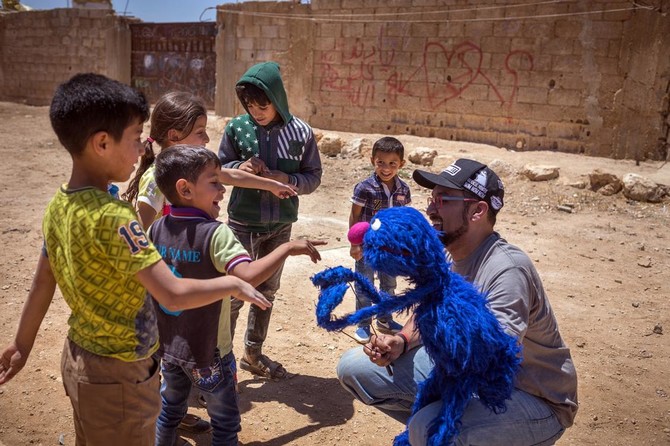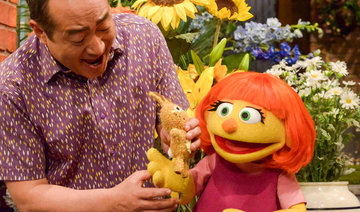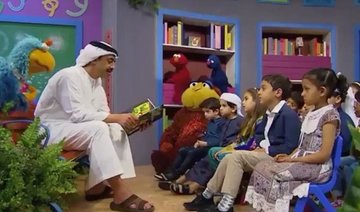ABU DHABI: Iftah Ya Simsim, the first international co-production of the US children’s television series Sesame Street created in the Arab world, is much-loved across the Middle East and recently opened its doors to Arab News for an exclusive, muppet-filled tour of the studio in Abu Dhabi.
The show premiered in Kuwait in 1979 and was broadcast in 22 Arabic-speaking countries before it went on a hiatus in 1990. However, 25 years later, it came back with a bang and is now on air with a new cast and great content suited to this day and age.
Walking into the show’s headquarters at the Bidaya Media office in Abu Dhabi is nostalgic to say the least. Gargoor, the Arabic-speaking version of Grover, and Ka’ki, the Cookie Monster, greeted my daughter and I in what was a wonderful and memorable experience.
The show just completed its second season, with the third set to air in September of this year with a new concept and new projects to look forward to. The award-winning television series targets the educational, social and language needs of children aged three to eight in the Middle East and North Africa region. In December, the producers of Iftah Ya Simsim joined forces with YouTube’s Creators for Change initiative, a global effort to amplify the voices of role models on YouTube. The news comes after the tremendous effort made by the team to promote the importance of positive behavior among children and tackle issues that they face on a day-to-day basis.
One of the show’s puppeteers, Ammar Sabban, spoke to Arab News about the intricacies of conveying a message to such a young audience.
“Each team behind the show plays a major role in providing content. It’s not difficult to convey an idea through fun and games, the difficulty lies in the way you convey it to grab the attention of viewers. As a puppeteer, I have to not only perfect the entertaining part, but also make sure that my Arabic is pronounced correctly, create comedy sketches, ensure the message is clear to cater to the younger audience, the behavioral lesson is relayed properly and so on and so forth,” he said.
“Growing up watching The Muppets and Sesame Street religiously gave me the advantage that I have now. The partnership with YouTube’s Creators of Change will help tackle negative, counter-productive and simply bad content on YouTube, especially as kids are more informed nowadays than ever. Everyone must play their part well, a responsibility I’m proud to take head on to make sure that this next generation turns more toward making a positive impact on the world rather than settling for mediocre,” he added.
Season three’s more than 50 episodes will feature the region’s top YouTube content creators. Iftah Ya Simsim creators will produce additional episodes that will be exclusively available on YouTube. The upcoming season’s theme will focus on respect, resilience and relationships — themes that are designed to encourage children’s social-emotional development by teaching them about self-esteem, embracing their identity and being positive, proactive members of society.
“We, as content creators ourselves, learn something new every day while working here. The same values that we grew up with watching Iftah Ya Simsim or Sesame Street are implemented today, only more evolved and more entertaining. We learn from some of the shortcomings of the previous seasons and strive to provide better content every time,” Sabban said.
Iftah Ya Simsim’s aim is to make a difference in children’s lives everywhere by encouraging them to learn as they play. Earlier in 2017, Sesame Street, in cooperation with the International Rescue Committee (IRC), requested that Sabban accompany them with his puppets on a visit to the Zaatari camp in Jordan to visit Syrian refugees. The idea behind such an initiative is to help Syrian children who have been displaced by the ongoing Syrian war and to give them a sense of normalcy through education.
The two organizations are developing a holistic early childhood learning and development program featuring the Sesame Street muppets. The program’s outreach initiative will be distributed through schools, community centers, social protection programs and more to help parents and caregivers support their children’s early learning and development.
“The idea behind the visit to the Syrian refugee camp by the Sesame Workshop and IRC is two-fold. One is to provide children with entertainment and the second, more importantly, is to educate them. Early childhood education in refugee camps is nonexistent. Part of the effort is to provide good, high-level early childhood education to displaced children and provide them with the support they need to learn, grow and thrive,” said Sabban.
Their effort has succeeded in securing a five-year, $100 million grant from the US-based MacArthur Foundation to educate the displaced children of the Middle East. This grant will help Sesame Workshop — along with its localized versions around the world, including Iftah Ya Simsim — to build child development centers in the region, provide them with storybooks, home visits by caregivers and more.
The team in Abu Dhabi is headed by Cairo Arafat, managing director of Bidaya Media, who believes “in the power of starting early and starting right.” It is incredibly important to provide children with suitable viewing to ensure healthy childhood development and Iftah Ya Simsim's snappy, 20-minute episodes will captivate children and go a long way in teaching them important life lessons.
Open Sesame! Behind closed doors at children’s show ‘Iftah Ya Simsim’
Open Sesame! Behind closed doors at children’s show ‘Iftah Ya Simsim’

A 98-year-old in Ukraine walked miles to safety from Russians, with slippers and a cane

- Describing her journey, the nonagenarian said she had fallen twice and was forced to stop to rest at some points, even sleeping along the way before waking up and continuing her journey
KYIV, Ukraine: A 98-year-old woman in Ukraine who escaped Russian-occupied territory by walking almost 10 kilometers (6 miles) alone, wearing a pair of slippers and supported by a cane has been reunited with her family days after they were separated while fleeing to safety.
Lidia Stepanivna Lomikovska and her family decided to leave the frontline town of Ocheretyne, in the eastern Donetsk region, last week after Russian troops entered it and fighting intensified.
Russians have been advancing in the area, pounding Kyiv’s depleted, ammunition-deprived forces with artillery, drones and bombs.
“I woke up surrounded by shooting all around — so scary,” Lomikovska said in a video interview posted by the National Police of Donetsk region.
In the chaos of the departure, Lomikovska became separated from her son and two daughters-in-law, including one, Olha Lomikovska, injured by shrapnel days earlier. The younger family members took to back routes, but Lydia wanted to stay on the main road.
With a cane in one hand and steadying herself using a splintered piece of wood in the other, the pensioner walked all day without food and water to reach Ukrainian lines.
Describing her journey, the nonagenarian said she had fallen twice and was forced to stop to rest at some points, even sleeping along the way before waking up and continuing her journey.
“Once I lost balance and fell into weeds. I fell asleep … a little, and continued walking. And then, for the second time, again, I fell. But then I got up and thought to myself: “I need to keep walking, bit by bit,’” Lomikovska said.
Pavlo Diachenko, acting spokesman for the National Police of Ukraine in the Donetsk region, said Lomikovska was saved when Ukrainian soldiers spotted her walking along the road in the evening. They handed her over to the “White Angels,” a police group that evacuates citizens living on the front line, who then took her to a shelter for evacuees and contacted her relatives.
“I survived that war,’ she said referring to World War II. “I had to go through this war too, and in the end, I am left with nothing.
“That war wasn’t like this one. I saw that war. Not a single house burned down. But now – everything is on fire,” she said to her rescuer.
In the latest twist to the story, the chief executive of one of Ukraine’s largest banks announced on his Telegram channel Tuesday that the bank would purchase a house for the pensioner.
“Monobank will buy Lydia Stepanivna a house and she will surely live in it until the moment when this abomination disappears from our land,” Oleh Horokhovskyi said.
Amazon Purr-rime: Cat accidentally shipped to online retailer

- Galena was found safe by a warehouse worker at an Amazon center after vanishing from her home in Utah
LOS ANGELES: A curious cat that sneaked into an open box was shipped across the United States to an Amazon warehouse after its unknowing owners sealed it inside.
Carrie Clark’s pet, Galena, vanished from her Utah home on April 10, sparking a furious search that involved plastering “missing” posters around the neighborhood.
But a week later, a vet hundreds of miles (kilometers) away in Los Angeles got in touch to say the cat had been discovered in a box — alongside several pairs of boots — by a warehouse worker at an Amazon center.
“I ran to tell my husband that Galena was found and we broke down upon realizing that she must have jumped into an oversized box that we shipped out the previous Wednesday,” Clark told KSL TV in Salt Lake City.
“The box was a ‘try before you buy,’ and filled with steel-toed work boots.”
Clark and her husband jetted to Los Angeles, where they discovered Amazon employee Brandy Hunter had rescued Galena — a little hungry and thirsty after six days in a cardboard box, but otherwise unharmed.
“I could tell she belonged to someone by the way she was behaving,” said Hunter, according to Amazon.
“I took her home that night and went to the vet the next day to have her checked for a microchip, and the rest is history.”
What did people eat before agriculture? New study offers insight

- Analysis of forms — or isotopes — of elements including carbon, nitrogen, zinc, sulfur and strontium in these remains indicated the type and amount of plants and meat they ate
WASHINGTON: The advent of agriculture roughly 11,500 years ago in the Middle East was a milestone for humankind — a revolution in diet and lifestyle that moved beyond the way hunter-gatherers had existed since Homo sapiens arose more than 300,000 years ago in Africa.
While the scarcity of well-preserved human remains from the period preceding this turning point has made the diet of pre-agricultural people a bit of a mystery, new research is now providing insight into this question. Scientists reconstructed the dietary practices of one such culture from North Africa, surprisingly documenting a heavily plant-based diet.
The researchers examined chemical signatures in bones and teeth from the remains of seven people, as well as various isolated teeth, from about 15,000 years ago found in a cave outside the village of Taforalt in northeastern Morocco. The people were part of what is called the Iberomaurusian culture.
Analysis of forms — or isotopes — of elements including carbon, nitrogen, zinc, sulfur and strontium in these remains indicated the type and amount of plants and meat they ate. Found at the site were remains from different edible wild plants including sweet acorns, pine nuts, pistachio, oats and legumes called pulses. The main prey, based on bones discovered at the cave, was a species called Barbary sheep.
“The prevailing notion has been that hunter-gatherers’ diets were primarily composed of animal proteins. However, the evidence from Taforalt demonstrates that plants constituted a big part of the hunter-gatherers’ menu,” said Zineb Moubtahij, a doctoral student in archaeology at the Max Planck Institute for Evolutionary Anthropology in Germany and lead author of the study published on Monday in the journal Nature Ecology & Evolution.
“It is important as it suggests that possibly several populations in the world already started to include substantial amount of plants in their diet” in the period before agriculture was developed, added archeogeochemist and study co-author Klervia Jaouen of the French research agency CNRS.
The Iberomaurusians were hunter-gatherers who inhabited parts of Morocco and Libya from around 25,000 to 11,000 years ago. Evidence indicates the cave served as a living space and burial site.
These people used the cave for significant portions of each year, suggesting a lifestyle more sedentary than simply roaming the landscape searching for resources, the researchers said. They exploited wild plants that ripened at different seasons of the year, while their dental cavities illustrated a reliance on starchy botanical species.
Edible plants may have been stored by the hunter-gatherers year-round to guard against seasonal shortages of prey and ensure a regular food supply, the researchers said.
These people ate only wild plants, the researchers found. The Iberomaurusians never developed agriculture, which came relatively late to North Africa.
“Interestingly, our findings showed minimal evidence of seafood or freshwater food consumption among these ancient groups. Additionally, it seems that these humans may have introduced wild plants into the diets of their infants at an earlier stage than previously believed,” Moubtahij said.
“Specifically, we focused on the transition from breastfeeding to solid foods in infants. Breast milk has a unique isotopic signature, distinct from the isotopic composition of solid foods typically consumed by adults.”
Two infants were among the seven people whose remains were studied. By comparing the chemical composition of an infant’s tooth, formed during the breastfeeding period, with the composition of bone tissue, which reflects the diet shortly before death, the researchers discerned changes in the baby’s diet over time. The evidence indicated the introduction of solid foods at around the age of 12 months, with babies weaned earlier than expected for a pre-agricultural society.
North Africa is a key region for studying Homo sapiens evolution and dispersal out of Africa.
“Understanding why some hunter-gatherer groups transitioned to agriculture while others did not can provide valuable insights into the drivers of agricultural innovation and the factors that influenced human societies’ decisions to adopt new subsistence strategies,” Moubtahij said.
Palestinian prisoner in Israel wins top fiction prize

- The mask in the novel’s title refers to the blue identity card that Nur, an archaeologist living in a refugee camp in Ramallah, finds in the pocket of an old coat belonging to an Israeli
ABU DHABI: Palestinian writer Basim Khandaqji, jailed 20 years ago in Israel, won a prestigious prize for Arabic fiction on Sunday for his novel “A Mask, the Color of the Sky.”
The award of the 2024 International Prize for Arabic Fiction was announced at a ceremony in Abu Dhabi.
The prize was accepted on Khandaqji’s behalf by Rana Idriss, owner of Dar Al-Adab, the book’s Lebanon-based publisher.
Khandaqji was born in the Israeli-occupied West Bank city of Nablus in 1983, and wrote short stories until his arrest in 2004 at the age of 21.
He was convicted and jailed on charges relating to a deadly bombing in Tel Aviv, and completed his university education from inside jail via the Internet.
The mask in the novel’s title refers to the blue identity card that Nur, an archaeologist living in a refugee camp in Ramallah, finds in the pocket of an old coat belonging to an Israeli.
Khandaqji’s book was chosen from 133 works submitted to the competition.
Nabil Suleiman, who chaired the jury, said the novel “dissects a complex, bitter reality of family fragmentation, displacement, genocide, and racism.”
Since being jailed Khandaqji has written poetry collections including “Rituals of the First Time” and “The Breath of a Nocturnal Poem.”
He has also written three earlier novels.
Mexican doctor claims victory in $28 Cartier earrings battle

MEXICO CITY: A Mexican man has claimed a victory over French luxury brand Cartier, saying an error allowed him to buy two pairs of earrings for $28 that were supposed to cost nearly $28,000.
After a four-month struggle, doctor Rogelio Villarreal said he had finally received the jewelry, which he accused the company of refusing to deliver after his online purchase in December.
According to Villarreal, he came across the low-priced earrings while browsing Instagram.
“I swear I broke out in a cold sweat,” he wrote on the social media platform X.
Cartier declined to recognize the purchase and offered Villarreal a refund, as well as a bottle of champagne and a passport holder as compensation, according to a company letter shared by the doctor.
But Villarreal refused and decided to take the case to Mexico’s consumer protection agency, which ruled in favor of the doctor.
Cartier accepted the decision, Villarreal announced.
“War is over. Cartier is complying,” he wrote.






















